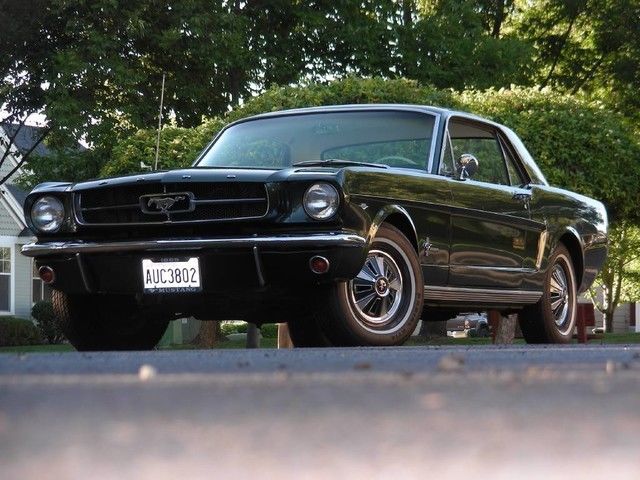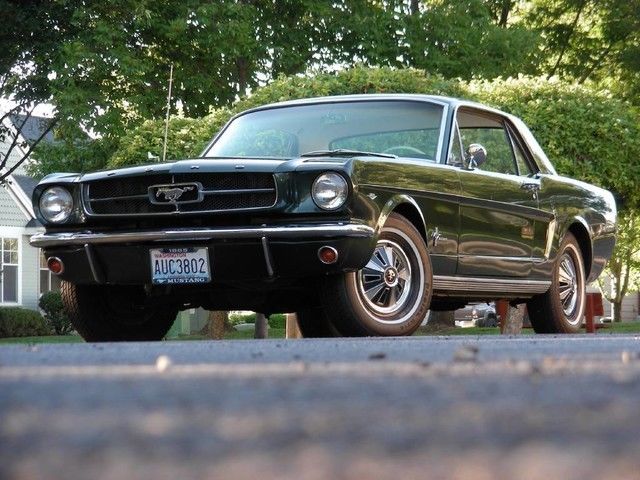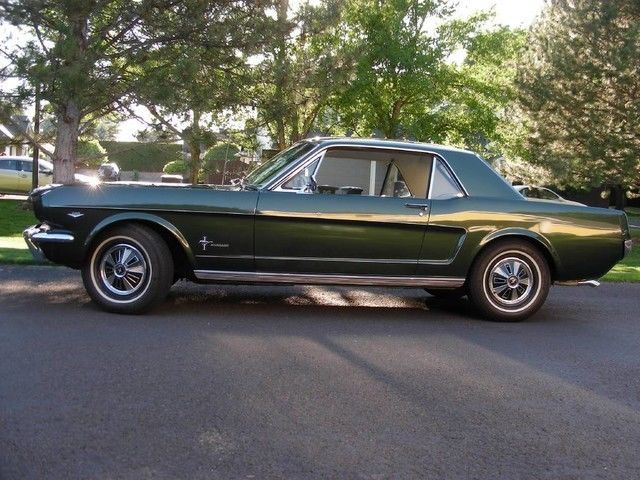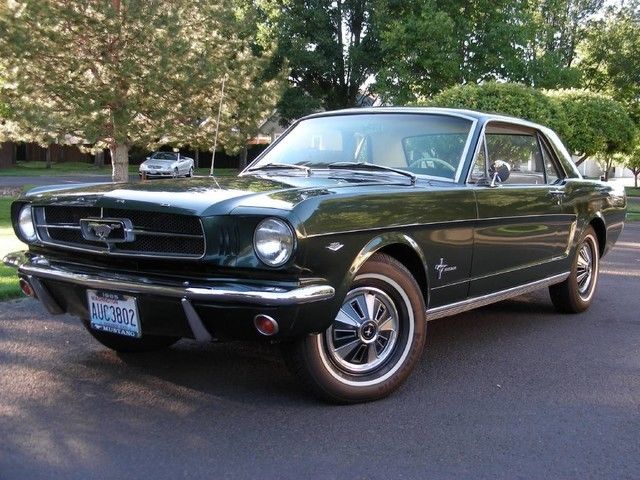1965 Ford Mustang 2dr HT Coupe 289 V8 4 spd
1965 Ford Mustang Coupe
Ford Mustang 1965 technical specifications | |
|---|---|
| Condition: | Used |
| Item location: | College Place, Washington, United States |
| Make: | Ford |
| Model: | Mustang |
| SubModel: | Coupe |
| Type: | Coupe |
| Doors: | 2 |
| Year: | 1965 |
| Mileage: | 108,492 |
| VIN: | 5R07C179864 |
| Color: | Green |
| Engine size: | 8 |
| Fuel: | Gas |
| Transmission: | Manual |
| Drivetrain: | Rear Wheel Drive |
| Interior color: | White |
| Vehicle Title: | Clear |
| You are interested? | Contact the seller! |
Description |
|---|
1965 Ford Mustang Coupe
Thank you for visiting another one of AUTOCHOICE Is Yours, LLC's exclusive listings! It is a rare occasion AUTOCHOICE has the privilege to represent a completely original untouched 1965 Mustang 2dr Sedan Coupe such as this one that is a two owner and been maintained on a regular basis and in near perfect mechanical condition with extremely low miles for the year. Please view all 100 plus photos carefully, they tell the story. When you see it in person, you will agree you won't find a nicer one. You want an original classic? This is the one, look no further. Call Don today (509) 301-1498 for a test drive appointment! You will be glad you did.Now, how about some MUSTANG history for your review:
From Wikipedia, the free encyclopedia Mustang first generation 1965 Ford Mustang Overview Manufacturer Ford Production March 1964–June 1973 Modelyears 1965–1973 Assembly Dearborn, Michigan San Jose, California Metuchen, New Jersey Valencia, Venezuela Mexico City, Mexico[1][2] Body and chassis Class Pony car Bodystyle 2-door hardtop 2-door fastback/sportsroof 2-door convertible Layout FR layout Related Ford Falcon Mercury Cougar Mercury Comet Ford Ranchero Chronology Successor Ford Mustang II Main article: Ford MustangThe first-generation Ford Mustang was manufactured by Ford from March 1964 until 1973. The introduction of the Mustang created a new class of automobile known as the pony car. The Mustang’s styling, with its long hood and short deck, proved wildly popular and inspired a host of imitators.
It was initially introduced as a hardtop and convertible with the fastback version put on sale in August 1965. At the time of its introduction, the Mustang, sharing its underpinnings with the Falcon, was slotted into a compact car segment.
With each revision, the Mustang saw an increase in overall dimensions and in engine power. The 1971 model saw a drastic redesign to its predecessors. After an initial surge, sales were steadily declining, as Ford began working on a new generation Mustang. With the onset of the 1973 oil crisis, Ford was prepared, having already designed the smaller Mustang II for the 1974 model year. This new car had no common components with preceding models.
Conception and stylingAs Lee Iacocca's assistant general manager and chief engineer, Donald N. Frey was the head engineer for the Mustang project — supervising the development of the Mustang in a record 18 months from September 1962 to March 1964.[3][4] — while Iacocca himself championed the project as Ford Division general manager.
Drawing on inspiration from the mid-engined Ford Mustang I concept vehicle, Lee Iacocca ordered development of a new "small car"[5] to vice-president of design at Ford, Eugene Bordinat. Bordinat tasked Ford's three design studios (Ford, Lincoln-Mercury, and Advanced Design) to create proposals for the new vehicle.[6]
The design teams had been given five goals[7] for the design of the Mustang: It would seat four, have bucket seats and a floor mounted shifter, weigh no more than 2,500 pounds (1,100kg) and be no more than 180 inches (4,572mm) in length, sell for less than $2,500, and have multiple power, comfort, and luxury options.
The Lincoln–Mercury design studio ultimately produced the winning design in the intramural contest, under Project Design Chief Joe Oros and his team of L. David Ash, Gale Halderman, and John Foster.[8][9]
In a 2004 interview, Oros recalls the planning behind the design:[10]
“ I told the team that I wanted the car to appeal to women, but I wanted men to desire it, too. I wanted a Ferrari-like front end, the motif centered on the front – something heavy-looking like a Maseratti [sic], but, please, not a trident – and I wanted air intakes on the side to cool the rear brakes. I said it should be as sporty as possible and look like it was related to European design. ”Oros added:
“ I then called a meeting with all the Ford studio designers. We talked about the sporty car for most of that afternoon, setting parameters for what it should look like -- and what it should not look like -- by making lists on a large pad, a technique I adapted from the management seminar. We taped the lists up all around the studio to keep ourselves on track. We also had photographs of all the previous sporty cars that had been done in the Corporate Advanced studio as a guide to themes or ideas that were tired or not acceptable to management.Within a week we had hammered out a new design. We cut templates and fitted them to the clay model that had been started. We cut right into it, adding or deleting clay to accommodate our new theme, so it wasn't like starting all over. But we knew Lincoln-Mercury would have two models. And Advanced would have five, some they had previously shown and modified, plus a couple extras. But we would only have one model because Ford studio had a production schedule for a good many facelifts and other projects. We couldn't afford the manpower, but we made up for lost time by working around the clock so our model would be ready for the management review.[8]
”L. David Ash is often credited with the actual styling of the Mustang. Ash, in a 1985 interview speaking of the origin of the Mustang design, when asked the degree of his contribution, said:
“ I would say substantial. However, anyone that says they designed the car by themselves, is wrong. Iacocca didn't design it. He conceived it. He's called the father of it, and, in that respect, he was. I did not design it in total, nor did Oros. It was designed by a design group. You look at the photograph taken at the award banquet for the Industrial Designers’ Society where the Mustang received the medal; it’s got Damon Woods in it (the group that did the interior), and Charlie Phaneuf (who was with Damon), and it’s got myself and John Foster (who was with me), it’s got (John) Najjar in it.[11] ” “ So nobody actually did the car, as such. Iacocca in his book flat out comes and says I did the car. It's right there in print, "It's Dave Ash's Mustang." Bordinat will tell you I did the car. This book tells you I did the car, but, in actual fact, I had a lot of help, and I don't think anyone ever does a car by himself, not in these times anyway.[11] ”Gale Haldeman, in a 2002 interview with Collectible Automobile, spoke of the Mustang's evolution through the Lincoln-Mercury studio:
“ Dave Ash had started a clay model of the car. He had this very boxy, very stiff-looking car. Joe came back from a management conference, saw it, and said, "No, no, no, we're not going to do that!" That's when he came to me....he said, "...we've just been given an assignment by [Gene] Bordinat to do a proposal on a small car that Lee [Iaccoca] wants to build. We've got to do one, and I want you to work on that project." I went home and sketched some cars, and I took about five or six sketches with me the next morning and put them up on the board. ” “ We must have put 25 sketches on the board that morning, because Joe assigned three or four of us to do designs. Joe picked one of the sketches I did at home to be clay modeled....so we actually started over on [Dave Ash's] clay model with the theme from one of my designs, which had scoops on the sides and the hop-up quarter lines.[12] ”To decrease developmental costs, the Mustang used chassis, suspension, and drivetrain components derived from the Ford Falcon and Fairlane. It used a unitized platform-type frame from the 1964 Falcon, and welded box-section side rails, including welded crossmembers. Although hardtop Mustangs accounted for the highest sales, durability problems with the new frame led to the engineering of a convertible first, which ensured adequate stiffness. Overall length of the Mustang and Falcon was identical, although the Mustang's wheelbase was slightly shorter. With an overall width of 68.2in (1,732mm), it was 2.4in (61mm) narrower, yet the wheel track was nearly identical. Shipping weight, approximately 2,570lb (1,166kg) with the straight six-cylinder engine, was also similar to the Falcon. A fully equipped V8 model weighed approximately 3,000lb (1,361kg). Although most of the mechanical parts were from the Falcon, the Mustang's body was completely different; sporting a shorter wheelbase, wider track, lower seating position and lower overall height. An industry first, the "torque box" was an innovative structural system that greatly stiffened the Mustang's construction and helped contribute to better handling.
Gale Haldeman spoke of the engineering and design of the car in his interview, stating:
“ No one knew the Mustang was going to be as popular as it was, but it created a huge stir in the company. Everybody just loved it, even the engineers, though we must have bent 75 in-house engineering and manufacturing rules. The Mustang had the first floating bumpers. The whole front end was a die-casting with a floating hood. ” “ There were so many things the engineers said we shouldn't be doing, but they didn't want to change them either. There was so much enthusiasm right from the beginning. Even the drivers at the test track loved it. We would go there for meetings, and the crowds of people around it were huge. That was totally unusual, so we suspected the Mustang was going to be a hit. ”The idea for a fastback originated with Joe Oros as well, and was designed in Charlie Phaneuf's studio.[13] Haldeman recalls as follows:[13]
“ We did it in secret. No one, including [Hal] Sperlich or Iacocca, saw it until it was finished. We cast it in fiberglass, painted it bright red, and then showed it to Iacocca. He said, "We've got to do it!" ”An additional 4-door model was designed by Dave Ash as a clay model, but was not considered.[5]
1964–1966 Mustang 1964–1966 1966 Ford Mustang Overview Production March 1964–July 1966 Assembly Dearborn, Michigan San Jose, California Metuchen, New Jersey Valencia, Venezuela Mexico City, Mexico[1][2] Designer Joe Oros David Ash Gale Haldeman Charlie Phaneuf (fastback) Philip T. Clark (Mustang I concept) John Najjar (Mustang I concept) Body and chassis Bodystyle 2-door hardtop 2-door fastback 2-door convertible Related Shelby Mustang Powertrain Engine 170cuin (2.8L) Thriftpower I6 200cuin (3.3L) Thriftpower I6 260cuin (4.3L) Windsor V8 289cuin (4.7L) Windsor V8 289cuin (4.7L) Windsor HiPo V8[14][15] Transmission 3-speed manual 4-speed manual 3-speed automatic Dimensions Wheelbase 108in (2,743mm) Length 181.6in (4,613mm) Width 68.2in (1,732mm) Height 51.2in (1,300mm)[16] Curbweight 2,445lb (1,109kg) (base)[17]Since it was introduced five months before the normal start of the 1965 production year and manufactured alongside 1964 Ford Falcons and 1964 Mercury Comets, the earliest Mustangs are widely referred to as the 1964½ model.[18] Nevertheless, all "1964½" cars were given 1965 U.S. federal VIN numbers at the time of production, and - with limited exception to the earliest of promotional materials[19] - were marketed by Ford as 1965 models.[20] The low-end model hardtop used a "U-code" 170cuin (2.8L) straight-6 engine[21] borrowed from the Falcon, as well as a three-speed manual transmission and retailed for US$2,368. Standard equipment for the early 1965 Mustangs included black front seat belts, a glove box light, and a padded dash board.[22] Production began in March 1964 and official introduction following on April 17 at the 1964 World's Fair.
Several changes to the Mustang occurred at the start of the normal 1965 model year production, five months after its introduction. These cars are known as "late 65's," and were built after factory retooling in August 1964. The engine lineup was changed, with a 200cuin (3.3L) "T-code" engine that produced 120hp (89kW; 122PS). Production of the "F-code" 260cuin (4.3L) engine ceased when the 1964 model year ended. It was replaced with a new 200hp (150kW) "C-code" 289cuin (4.7L) engine with a two-barrel carburetor as the base V8. An "A-code" 225hp (168kW; 228PS) four-barrel carbureted version was next in line, followed by the unchanged "Hi-Po" "K-code" 271hp (202kW; 275PS) 289. The DC electrical generator was replaced by a new AC alternator on all Fords (a way to distinguish a 1964 from a 1965 is to see if the alternator light on the dash says "GEN" or "ALT"). The Mustang GT version was introduced as the "GT Equipment Package" and included a V8 engine (most often the 225hp (168kW; 228PS) 289), grille-mounted fog lamps, rocker panel stripes, and disc brakes. In the interior the GT option added a different instrument panel that included a speedometer, fuel gauge, temp. gauge, oil pressure gauge and ammeter in five round dials (the gauges were not marked with numbers, however.)[23] A four-barrel carbureted engine was now available with any body style. Additionally, reverse lights were an option added to the car from August 1964 production. The Mustang was originally available as either a hardtop or convertible, but during the car's early design phases a fastback model was strongly considered. In 1965, the Shelby Mustang was born, it was available only in newly introduced fastback body version with its swept-back rear glass and distinctive ventilation louvers.[24]
The standard interior features of the 1965 Mustang included adjustable driver and passenger bucket seats, an AM radio, and a floor mounted shifter in a variety of color options. Ford added additional interior options during the 1965 model year. The Interior Decor Group was popularly known as "Pony Interior" due to the addition of embossed running ponies on the seat fronts, and also included integral armrests, woodgrain appliqué accents, and a round gauge cluster that would replace the standard Falcon instrumentation. Also available were sun visors, a (mechanical) remote-operated mirror, a floor console, and a bench seat. Ford later offered an under-dash air-conditioning unit, and discontinued the vinyl with cloth insert seat option, offered only in early 1965 models. One option designed strictly for fun was the Rally-Pac. Introduced in 1963 after Ford's success at that year's Monte Carlo Rally and available on other Ford and Mercury compacts and intermediates, the Rally-Pac was a combination clock and tachometer[25] mounted to the steering column. It was available as a factory ordered item for US$69.30. Installed by a dealer, the Rally-Pac cost US$75.95.A 14" rim option was available for Rally-pac and GT350R vehicles widening front and rear track to 57.5". Reproductions are presently available from any number of Mustang restoration parts sources.[24] A compass, rear seat belts, A/C, and back-up lights were also optional.[25]
Nationwide survey of owners by Popular Mechanics included many complaints about leg room.[26] Fuel economy was very good for the period, with a published test by Popular Mechanics rating the small 260 cubic inch V8 with automatic transmission at 20.93 mpg at 60mph.[26]
The 1966 Mustang debuted with moderate trim changes including a new grille, side ornamentation, wheel covers and gas cap. Ford's new C-4 "cruise-o-matic" three-speed auto transmission became available for the 225hp V8. The 289 "HiPo" K-code engine was also offered with a c4 transmission, but it had stronger internals and can be identified by the outer casing of the servo which is marked with a 'C'. The long duration solid-lifter camshaft that allowed the high revving 289 to make the horsepower it was known for, was not friendly for a low stall speed automatic torque converter. The "HiPo" could be spotted very easily by the 1-inch-thick (25mm) vibration damper, (as compared to 1/2inch on the 225-hp version) and the absence of a vacuum advance unit on the dual point distributor. With the valve covers off, there is a large letter "K" stamped between the valve springs, that along with screw in studs (vs. a pressed in stud for other 289s) for the adjustable rocker arms. A large number of new paint and interior color options, an AM/eight-track sound system, and one of the first AM/FM mono automobile radios was also offered. It also removed the Falcon instrument cluster; the previously optional features, including the round gauges and padded sun visors, became standard equipment. The Mustang would be the best-selling convertible in 1966, with 72,119 sold, beating the number two Impala by almost 2:1.[27]
The 1965 and 1966 Mustangs are differentiated by variations in the exterior, despite similar design. These variations include the emblem on the quarter-panels behind the doors. From August 1964 production, the emblem was a single vertical piece of chrome, while for 1966 models the emblem was smaller in height and had three horizontal bars extending from the design, resembling an "E". The front intake grilles and ornaments were also different. The 1965 front grille used a "honeycomb" pattern, while the 1966 version was a "slotted" style. While both model years used the "Horse and Corral" emblem on the grille, the 1965 had four bars extending from each side of the corral, while on the 1966, these bars were removed. The 1966 model year saw introduction of 'High Country Special' limited edition, 333 of them were sold in Colorado, Wyoming, and Nebraska.[28]
When Ford wanted to introduce the Mustang in Germany, they discovered that Krupp company had already registered the name for a truck.[29] The German company offered to sell the rights for US$10,000. Ford refused and removed Mustang badges from exported units, instead naming the cars as T-5 (a pre-production Mustang project name) for the German market until 1979 when Krupp copyrights expired.[29]
1965 Mustang AWD PrototypeIn 1965, Harry Ferguson Research purchased 3 Mustang notchbacks and converted them to 4x4 in an attempt to sell potential clients on their FF AWD system.[30] A similar system was used in the Ferguson P99 Formula One car, and would go on to be featured in the Jensen FF, widely considered the first AWD passenger car. As in the Jensen FF, the AWD Mustangs also featured an ABS braking system, long before such a feature was commonplace.[citation needed]
Hardtop Fastback Convertible 1966 Ford T-5 emblem Front end styles 1965 Prototype with Ferguson AWD and ABS 1965 Prototype with Ferguson AWD and ABS



 1965 Ford Mustang Coupe 4.7L
1965 Ford Mustang Coupe 4.7L
 1965 Ford Mustang Coupe K-Code Hi-Po
1965 Ford Mustang Coupe K-Code Hi-Po
 1965 Ford Mustang California Car Coupe
1965 Ford Mustang California Car Coupe
 1965 Ford Mustang Coupe - Classic Beauty
1965 Ford Mustang Coupe - Classic Beauty
 1965 Ford Mustang Coupe 289 Pony Interior
1965 Ford Mustang Coupe 289 Pony Interior
 1965 Ford Mustang coupe 289 gt 350 body modlings
1965 Ford Mustang coupe 289 gt 350 body modlings
 1965 Ford Mustang Coupe BARN FIND PROJECT!!!
1965 Ford Mustang Coupe BARN FIND PROJECT!!!
 1965 Ford Mustang GT350 Coupe 289 V8 Auto w/ Powersteering
1965 Ford Mustang GT350 Coupe 289 V8 Auto w/ Powersteering
 1965 Ford Mustang Coupe Restomod 289 V8 Auto w/ Disc Brakes
1965 Ford Mustang Coupe Restomod 289 V8 Auto w/ Disc Brakes
 1965 Ford Mustang Coupe, 289 3 Speed, GT, A/C, PS, PB, Pony Interior, Console
1965 Ford Mustang Coupe, 289 3 Speed, GT, A/C, PS, PB, Pony Interior, Console